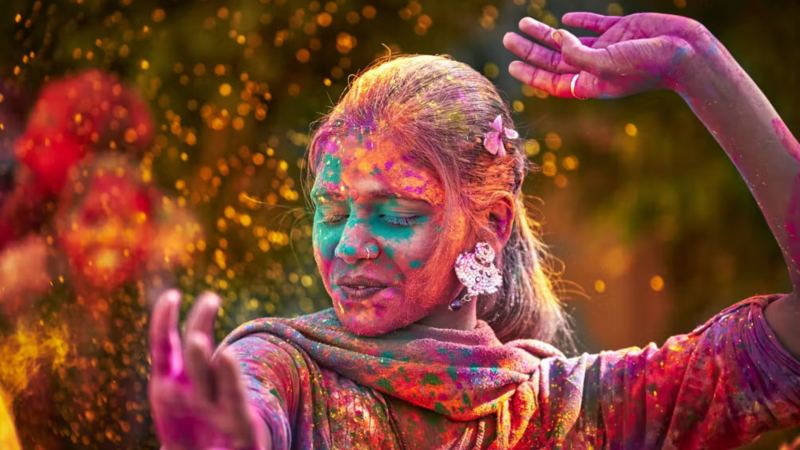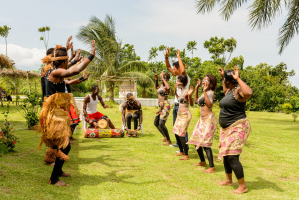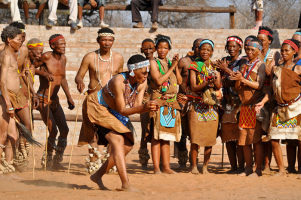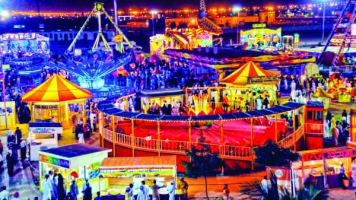Top 10 Most Famous Festivals in Nepal
Nepal is one of the few diversified locations, offering a wide range of natural, cultural, religious, and lifestyle options. Each Nepalese community celebrates ... read more...their customs in their own way. The majority of these traditions date back several centuries and are observed for specific reasons and with color. There is a reason why Nepal is known as the Land of Festivals. The number of festivals on the calendar is extensive due to the concentration of several settlements. Each community respects and enjoys the culture of the others. This is the primary reason behind Nepal's harmonious way of life. It is difficult to include all of Nepal's festivals. However, we have made an effort to identify the ten most famous festivals in Nepal that have piqued the curiosity of travelers from all over the world.
-
Dashain and Tihar are Nepal's two most important and well-known festivals. Dashain is a Hindu mythology festival of Goddess Durga's victory over the demon Mahishasura, whereas Tihar is a Hindu mythology celebration of lights and color dedicated to Goddess Laxmi, the god of wealth and prosperity. Despite the fact that these holidays are associated with a certain faith, their symbolic significance is firmly embedded in Nepalese culture. People of all ethnicities celebrate Dashain and Tihar with equal enthusiasm and excitement, regardless of their religious beliefs. The two festivals take place in the autumn season and are considered the longest festival holidays in the world.
Dashain is a 15-day festival in Nepal where people spend time with their families, eat delicious dishes, and receive tika and blessings from the old. After two weeks of Dashain, Tihar, the festival of lights and flowers, arrives. Tihar is a five-day event in which Nepalese people honor dogs for their devotion by showering them with garlands and delicious food. Furthermore, Bhaitika, the last day of Tihar, honors the bond between a brother and a sister.

Photo: Ayan Holidays 
Photo: Travel with Nepal Kameleon Holidays. -
The cow carnival is referred to as Gai Jatra. However, the celebration is held to remember loved ones who have died. To march along the street, people sing, dance, and dress up like cows. It is an event held to help people cope with the loss of a loved one.
Gai Jatra has its origins in Nepal under the reign of The Malla. According to legend, when a Malla queen was grieving the loss of her son, the king sent out a procession of people who had lost loved ones to show the queen that she was not alone. Gai Jatra has become one of Nepal's most popular events since then. It is mostly observed by the Newar community. The festival, on the other hand, is well-known across the country.

Photo: Wall Street Journal 
Photo: Tibet Vista -
In Nepal, Janai Purnima is a prominent celebration. On this auspicious full moon day, Hindu males renew their holy thread known as 'Janai,' which is known as Janai Purnima. People also go to Shiva temples, and a large Mela is conducted in various holy spots, such as Gisaikunda near Rasuwa, which attracts a large number of devotees.
Apart from that, families get together to eat sprout lentils, which are known in Nepali as 'Kwati.' Rakshya Bandhan, a rite in which sisters tie a thread on their brother's hand and get presents, is also part of Janai Purnima. However, there is a deeper purpose to the practice; it is a celebration and prayer to deepen the love and respect between sisters and brothers.

Photo: Pinterest Video: Kantipur TV HD -
Teej is one of Nepal's most important celebrations, with women from all around the country participating. Teej is celebrated by women wearing red sarees, tikas, and bangles, and singing and dancing for days. It is traditionally very important for married ladies to visit their mother homes and feast on traditional Dar dishes.
Women who follow Dar fast for a full day without food or drink, singing and dancing in groups. Married ladies pray to Lord Shiva for the lifespan and prosperity of their husbands, while unmarried women pray for a decent husband and marital bliss while fasting. On Teej, many ladies flock to Pashupatinath to offer their prayers; the sight of so many women dancing joyously is breathtaking. The sight of ladies of all ages, young and elderly, dancing for hours in the heat, rain, and without a drop of water or sustenance for a whole day is amazing.

Photo: Tibet Vista 
Photo: Tibet Vista -
Another festival in our list of the most famous festivals in Nepal is Fagun Purnima. The word Fagun Purnima, popularly known as Holi, is derived from the name of the fabled demon Holika. Holi, like many other Nepalese celebrations, has a relation to Hindu mythology. It begins the triumph of good over evil. According to mythology, Prahalad, a little boy, was a follower of Lord Bishnu, whom his father, demon king Mahisasur, deemed a fatal adversary. In a fit of wrath, the demon king directed his sister Holika, who possessed fire immunity, to murder his own son. Then there was Holika, who sat on fire with Prahalad, but she was the one who died in the flames while the boy survived.
People play Holi, a festival of colors, pleasure, and happiness, to commemorate the miracle. Holi is a Hindu festival that takes place in late February or early March. Holi has been increasingly popular among travelers in recent years.

Photo: Festivals Of Nepal 
Photo: Responsible Adventures -
Maghe Sankranti is observed on the first day of the Nepalese calendar's Magh months. It marks the beginning of the holy month, which is normally around the middle of January. The festival wishes to bring an end to the chilly season and wishes for warmer weather as well as greater health and fortune. On this day, families gather to share great meals. Tradition dictates that people consume sesame seed sweets, ghee, molasses, sweet potatoes, and yams.
Furthermore, the Tharu community in Terai celebrates Maghi- The New Year on the same day. They celebrate by gathering with family, eating great delicacies, visiting Melas, and dressing up in traditional attire.

Photo: Embassy of Brazil in Kathmandu 
Photo: Bhaktapur -
Indra Jatra is one of the most exciting and beloved events of the Kathmandu Valley's Newar population. It is an eight-day Jatra event held in September. This festival also kicks off the autumn festival season, which lasts a month. It commemorates the period when Indra descended to Earth; according to Hindu mythology, Indra is the King of Heaven.
The Jatra begins with the building of a pinewood pole in Basantapur Square, in front of the historic Hanuman Dhoka Palace. In addition, the chariot of the Living Goddess Kumari is paraded through Kathmandu's streets. Thousands of people attend to see the joyous procession led by masked dancers known as Lakhey.

Photo: Travellive 
Photo: Above the Himalaya Trekking -
One of Nepal's most important celebrations is Mahashivaratri, also known as Shiva's Night. According to Hindu mythology, Lord Shiva is the ultimate god. According to beliefs, the stars are in an optimal position on the day of Shivratri, which increases spiritual energy.
On this day, hundreds of Hindu devotees attend the Hindu holiest shrine, the Pashupatinath temple, which is also regarded as the protector of Kathmandu valley and Nepal. The Pashupatinath temple is decorated with flowers for this event. On this day, Sadhus travel from all over India to pray at Pashupati and conduct Lord Shiva's mystical Tandav dance. Because it is a night celebration, believers celebrate all night, shouting and praying for light to triumph over darkness. On Shivratri, people congregate at home, build bonfires, and make holy meals.

Photo: Across Himalaya 
Photo: iDesign -
Every location and religion has its own calendar year. The Georgian calendar is not for everyone. When it comes to Nepal, Buddhism is a major religion, and the inhabitants celebrate Losar as the start of the year.
You must, once again, consider the diversity. Although the entire country celebrates Losar as New Year, the exact day differs by municipality. Sonam Losar is observed by the Yolmo and Tamang groups, Tola Losar by the Gurung communities, and Gyalba Losar by the Sherpa and native Tibetan people of the hills.
Losar celebrations include dancing, merrymaking, family feasts, religious rites, processions at monasteries, mask dances by monks, religious scroll display, and other activities. This is an excellent time to sample a variety of Nepalese dishes.

Photo: Holidays to Nepal 
Photo: Holidays to Nepal -
Rounding out the list of most famous festivals in Nepal is Chhath. According to the lunar calendar, this is a four-day feast that takes place in November or October. This event is observed by Mithila locals and is the Terai community's hallmark festivity. This festival's ceremonies are centered on paying homage to the Sun God for his benevolence and light over the people. During the day, the villagers fast and pray for success and wealth.
They sit down for a magnificent feast after admiring the sunset. Other essential traditions of this event include a holy plunge in the river, water diving, and the preparation of unique foods for the Sun God, among others.
You get to enjoy those delicacies after fasting. Anarsa and Thekuwa are two of the best foods to taste during this event. Unfortunately, these dishes are not typically prepared at other times.

Photo: The Himalayan Times 
Photo: Holidays to Nepal































